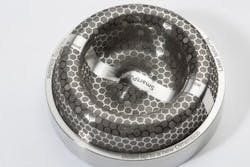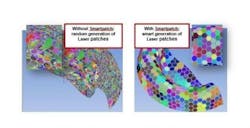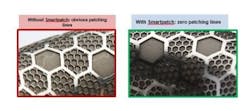Laser texturing software guarantees quality and productivity
ADRIEN RODRIGUES
Significantly greater productivity—ranging from 20% to 40%, depending on the specific application—and quality are among the cost-saving benefits reported by early adopters of GF Machining Solutions' latest-generation GF Laser Workstation Software. Moreover, testing in their own application centers confirms that the optional software suite with Smartpatch technology can accelerate texturing speed by 30% compared to the speed of the same process without Smartpatch.
These gains in production efficiency and quality are made possible by the process intelligence engineered into GF Laser Workstation Software 1.8.0's Smartpatch technology. With advanced generation of sections—or patches—of texture, the technology brings together smart machining strategies, increased quality, and optimized productivity to move customers into the future and advance laser texturing as a manufacturing process.
In the highly competitive and fast-moving mold and die environment, manufacturers do not have a moment to waste in their processes and cannot afford to compromise on quality. They are under increasing pressure to produce the highest-quality textured surfaces on the first attempt to reduce their turnaround time, keep their costs in check, and maintain their reputation for producing high-quality work.
Laser texturing applies textures to workpieces by using a laser beam to remove workpiece material layer by layer in a non-polluting, non-contact way. The technology has proven itself as a sustainable means of applying decorative textures, including complex geometries, over infinite iterations with highest repeatability because the process is fully digital. This means that virtually any design in a digital format can easily be applied to a 3D workpiece surface. Furthermore, since the cutting tool is a laser beam, tool wear and breakage are never an issue.
Challenges still exist, however, and GF Machining Solutions has resolved those challenges with intelligent texturing technologies.
The challenge
A significant hurdle is the scattershot approach of conventional laser texturing solutions. To date, even the most advanced laser texturing solutions have forced manufacturers to make some sacrifices in terms of either quality or productivity. This is because most existing laser texturing machines randomly apply textures to the workpiece surface, working from one area to the next to remove material in patches.
Without a smart-patching solution, productivity and quality are compromised because of inefficient texturing strategies and texturing errors induced by the movement of the laser head. Every patch or section of texture requires the machine head to move. Movement can induce position deviations from the desired texture design because of thermal changes in the environment around the machine. This can result in undesirable lines along the perimeters of patches and distorted textural details (FIGURE 1). These deviations lead to quality errors that are especially noticeable on very fine textures such as injection-molded automotive interiors, watches, information and communications technology (ICT) products, and many other challenging applications.
The solution
To establish the quality- and productivity-enhancing advantages of Smartpatch, GF Machining Solutions' Laser Research and Development team developed a highly demanding stainless steel demo part featuring a complex honeycomb texture (FIGURE 2).
Without Smartpatch, this workpiece required 30 times more patches. With the solution, a customer can produce the same workpiece with 30X fewer machine movements than with a program generated by standard methods.
FIGURE 3 shows how a standard laser process will machine a texture from the first layers to the last one, while FIGURE 4 shows where the smart technology detects a "pocket" (one area where the texture could be unlinked and where the texture's detail could be realized in a single movement). As soon as a pocket is detected, the machine makes a patch around it and executes all the layers of this pocket to finish it, sometimes with even fewer layers than were needed in the past.
With the intelligent machining strategies embedded in the software, texturing productivity and quality are significantly increased because machine movements are reduced by the number of layers of the targeted texture.
The intelligence embedded in the software reduces machine movements by analyzing the desired texture in advance and manages the machining process to eliminate movement-induced deviations from the desired texture.
Because of this embedded intelligence, random application of textures becomes a thing of the past because the laser head movement is minimized to deliver highly efficient texturing and high-quality results. In FIGURE 5, each color represents a machine movement in machining of the volcano workpiece without the smart-patching technology, and illustrates the efficiency lost by repositioning the laser head for each detail of the texturing application.
Without Smartpatch, for each layer, the texture's details are split randomly by a patch. Each patch is one machine movement. This influences the final part's quality since on fine texturing, each patch generates a new machine movement and the thermal changes can generate shifts in position.
With this solution, one detail of a texture is started and finished in a single movement, decreasing the number of patches executed by the numbers of layers set up by the customer and avoiding the risk of positioning deviation and consequent quality deviation.
FIGURE 5 clearly shows the efficiency gained by using the solution’s smart generation of laser patches.
An additional quality-advancing benefit of this solution is its ability to avoid patching lines and respect the desired geometry of the workpiece (FIGURE 6). It also shows the vast differences between texturing with and without GF Machining Solutions' smart patching technology. The image on the left shows that the texture’s borders are cropped as a result of the many random patches generated on each machined layers. The image on the right proves the respect for detail delivered by the software’s ability to machine successive layers without repositioning the laser head.
FIGURE 7 shows a sectional view of the texture without Smartpatch, where we can clearly see the geometry shift compared to the one with Smartpatch (FIGURE 8), where the slope is much more regular.
With the texturing efficiency enabled by Smartpatch, the volcano demo part was machined with the objective of achieving the best quality. A 30% faster process was achieved, compared to machining without the smart machining strategy (with a 30W nanosecond Flexipulse fiber laser source).
In addition to GF Machining Solutions' own tests, feedback from users in industry confirms these results. Using the AgieCharmilles LASER P 1000 U and AgieCharmilles LASER P 1200 U, an Italian die-cast and injection-mold finishing company reported that the smart laser patching solution benefited 50% of his production with laser texturing over a six-month testing period. Furthermore, the same user reported that the technology helps his business achieve much better quality and productivity—a truly revolutionary achievement that Smartpatch guarantees.
As another example, Smartpatch has been thoroughly tested by a Germany-based laser texturing and cast parts repair services provider. This user reported that his productivity increased 20% when using the software to execute a five-axis laser-textured part for automotive, and a 40% increase in productivity on a three-axis engraving application for automotive.
Conclusion
The intelligent machining strategies enabled by the Smartpatch technology in GF Machining Solutions' AgieCharmilles Laser Workstation revolutionize laser texturing by advancing both quality and productivity. This solution does this by executing efficient patching strategies that reduce movement of the laser head to significantly decrease the possibility of movement-induced errors and patching lines.
ADRIEN RODRIGUES is laser product manager for GF Machining Solutions SA, Geneva, Switzerland; www.gfms.com.








